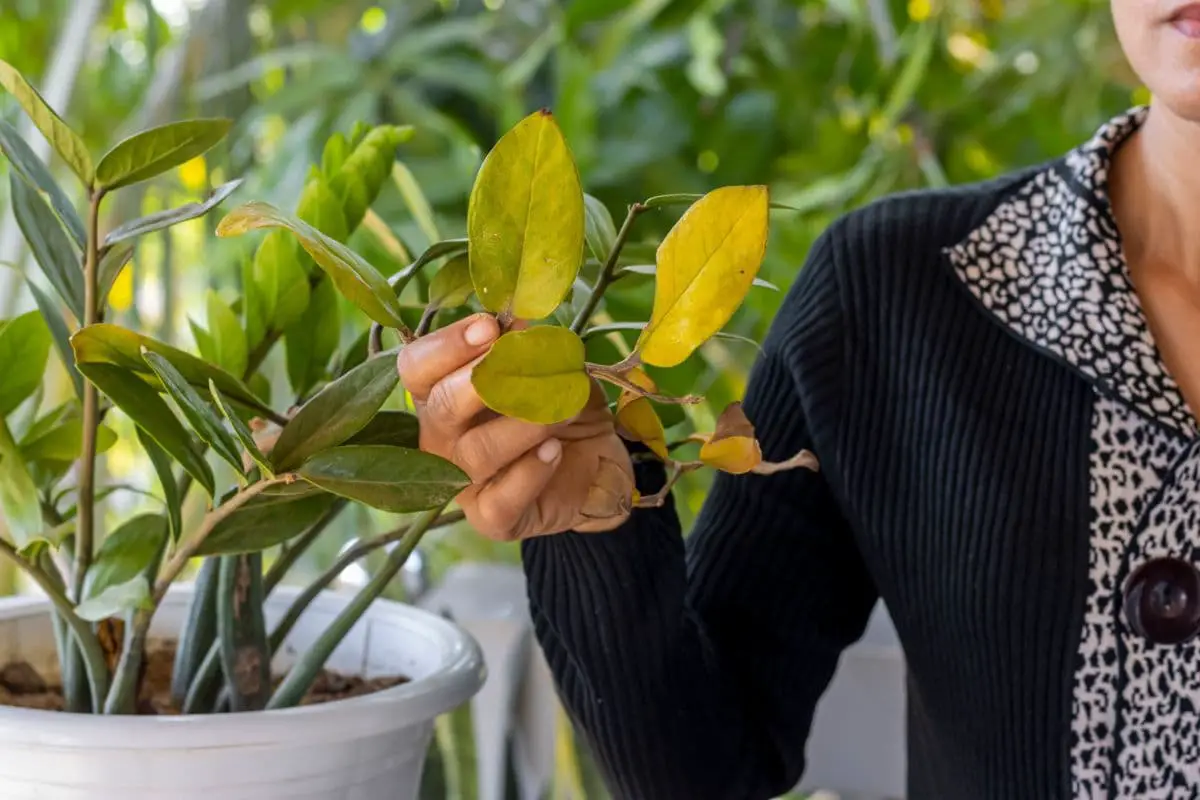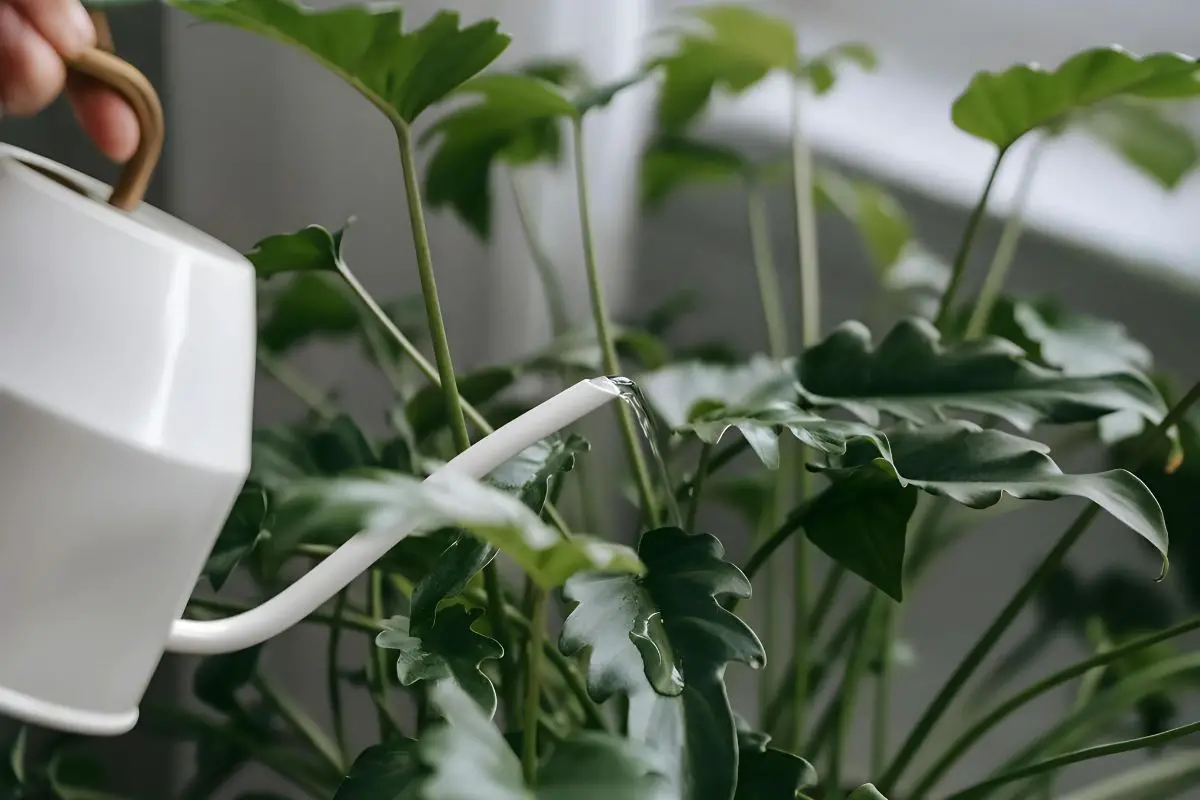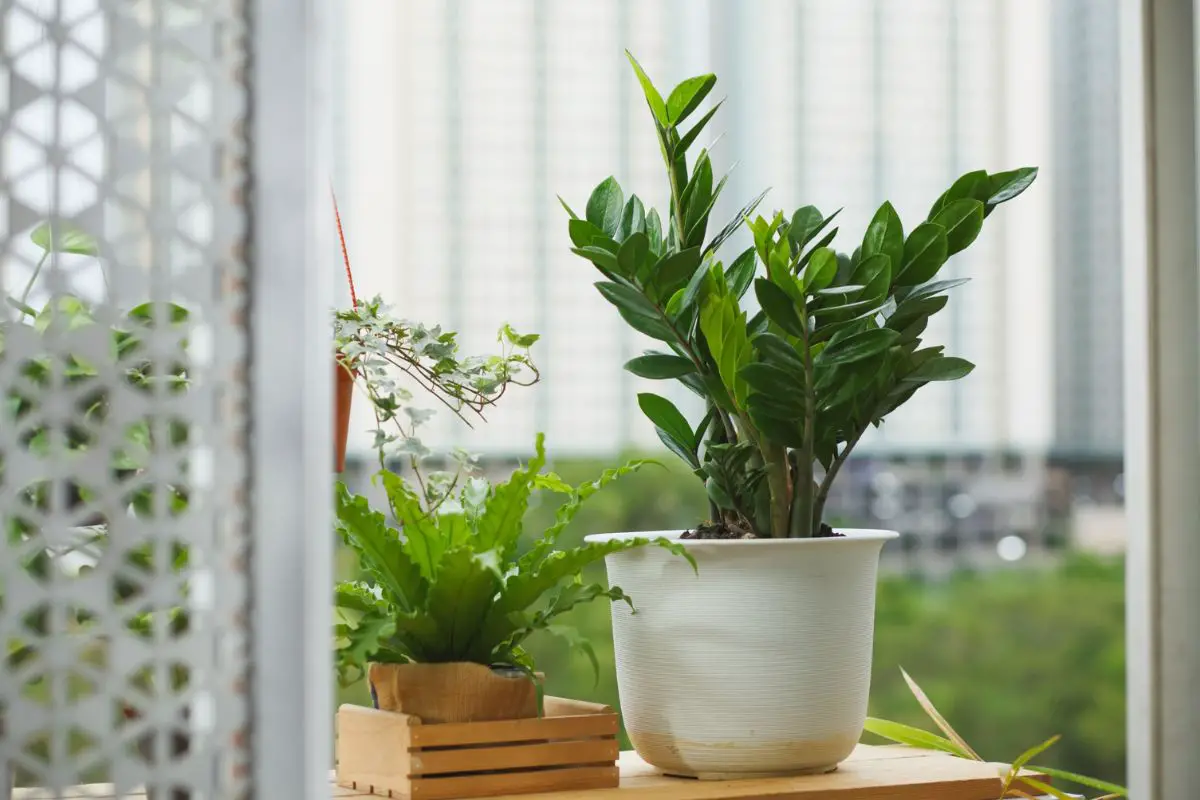ZZ plants are popular for their rich, emerald-green leaves, which stay vibrant even in the cold season. With minimal maintenance and occasional fertilization, you can enjoy their lush foliage year-round.
You must fertilize ZZ plants in spring and early summer between repotting. Use a slow-release balanced fertilizer every 3 months or apply liquid fertilizer monthly during this period.
In the rest of the article, I’ll explain how to tell when your ZZ plants need fertilizing and discuss different ways to feed them. I’ll also share feeding tips to encourage your plant to produce flowers.

ZZ Plant Nutrient Requirements: An Overview
ZZ plants (Zamioculcas zamiifolia) are flowering tropical perennials. They grow slowly and don’t require frequent fertilization.
They have potato-like rhizomes that absorb and store moisture and nutrients from the roots to help support the shoots against drought. Using light energy, the plant converts carbon dioxide and water into starch and stores them in the rhizomes.
These mechanisms allow ZZ plants to go several years without additional fertilization in the wild.
Potted ZZ plants, on the other hand, may need occasional fertilization, as nutrients can leach out through the drainage holes with regular watering.
Here are the essential nutrients for ZZ plant growth:
- Nitrogen: Famous for their foliage, ZZ plants need a good dose of nitrogen to maintain the stems and leaves.
- Phosphorus: It helps maintain a robust root system and healthy rhizomes. It’s also an essential component of ATP, enabling plant metabolic processes.
- Potassium: This mineral regulates stomatal opening, facilitating gas exchange and nutrient transport from the roots to the shoots.
ZZ plants may also need the following nutrients in trace amounts to help with nitrogen transport, metabolic processes, and chlorophyll generation:
- Iron
- Calcium
- Magnesium
- Manganese
- Zinc
Signs of Nutrient Deficiencies
Soil testing is a useful procedure to check nutrient levels and microbial populations in the garden.
However, it can be impractical for potted indoor ZZ plants, which you must repot in fresh soil mix every 2-3 years. The key is to use a high-quality potting mix from reputable sellers or make a homemade recipe with compost and perlite.
You can diagnose nutrient deficiency in ZZ plants through the following symptoms:
- Yellowing leaves in older stems (nitrogen)
- Yellow leaf surface with green veins or interveinal chlorosis (iron or magnesium)
- Stunted growth or lack of new leaf growth, even in spring and summer
- Curled leaves (potassium, phosphorus, calcium, magnesium)
When to Fertilize ZZ Plants
Consider these two factors to decide when to fertilize your ZZ plants:
Regular Application
Fertilize ZZ plants in the spring the year after planting in a high-quality potting mix with compost. The gentle dose of nutrients from the compost, the slow-growing nature of ZZ plants, and the efficiency of the rhizomes can help maintain your plant’s vigor.
Pro tip: I usually repot my ZZ plants every 2 years, so I apply a slow-release fertilizer only once, typically in early spring one year after transplant. If I keep the plant in the same pot for 3 years, I apply a second dose in early summer and a third dose the following spring.
Symptomatic Treatment
You must also fertilize your plants when they show symptoms of nutrient deficiency. Rule out other stress causes, such as light, temperature, and water problems before fertilizing your plant to avoid worsening the damage.
Use a half-strength balanced liquid fertilizer for faster absorption. Reapply the fertilizer every 4 weeks if it’s still within the growing season (until late summer).
Avoid applying fertilizers during winter because the low watering frequency during the cold season can increase the risk of fertilizer burn.

Types of Fertilizers
ZZ plants are not picky about fertilizer types, but you’ll achieve the best results when you use the right type of fertilizer for your plant’s health and growth stage.
Compost
Compost doubles as a soil amendment and gentle fertilizer. It contains low amounts of nitrogen, phosphorus, potassium, and other trace elements, sufficient for light feeders like ZZ plants.
This is best for young transplants whose roots and rhizomes are still too sensitive to fertilizer burn from chemical fertilizers.
Slow-Release Granular Fertilizer
Each granule has a partially water-soluble coating that gradually releases nutrients every time you water your plant.
This is the best fertilizer type for mature ZZ plants because the slow release of nutrients can nourish the shoots while protecting the roots and bulbs underneath the soil.
Avoid applying it directly over exposed bulbs. The chemical reaction with water can generate heat, and the salt released from each granule can draw moisture out of the bulbs.
To ensure your plant is well-fed, choose a product with a 10-10-10 NPK content with trace amounts of iron, magnesium, manganese, calcium, and zinc.
Liquid Fertilizer
You can use a balanced 10-10-10 liquid fertilizer with micronutrients for ZZ plants at any growth stage. However, the concentration and the frequency of application can vary.
- Young transplants or divisions: Quarter strength once a month (3 months after transplant in a nutrient-poor potting mix)
- Mature plants: Half-strength once a month from spring to late summer
Choose a fertilizer you can dilute in water and feed directly into the soil for regular feeding. I recommend Miracle-Gro Tropical Houseplant Food because it’s safe for ZZ plants and other tropical foliage plants like monsteras and pothos.
It also contains essential micronutrients for optimum health. However, it has a 1-0.5-1 formulation, so it’ll likely inhibit flowering.
How To Fertilize ZZ Plants
Here are some fertilizer application tips to maximize the efficiency rate without risking over-fertilization:
Preparing for Fertilization
Prepare the necessary materials for fertilization, including the following:
- Fertilizer
- Scoops or measuring cups
- Watering can with a narrow spout
- Wooden chopstick for stirring
Pro tip: Keep the fertilizers in their original packaging and with the product label intact. Each fertilizer has product-specific measurement or dosage instructions that you should follow to avoid harming your plant.
Fertilization Techniques
In addition to the product labels, follow the tips below to ensure your ZZ plant gets the most out of the fertilizers:
Granular
- Top up the potting mix to ensure the bulbs are at least ½ inch (1.3 cm) below the surface.
- Apply a thin, even layer of fertilizer over the soil surface. You can spread or rake them in using a small pot rake or hand cultivator.
- Keep the granules at least a quarter inch (0.6 cm) away from the base of the stems to prevent the salts from drawing out moisture from the plant cells.
- Water the soil from the top using a watering can with a narrow spout to avoid dislodging the granules.
Liquid
- Dilute the solution to a quarter or half of the recommended strength to avoid over-fertilization. Formulations are usually based on 1-gallon (3.8 l) solutions. If the original formulation says 2 ounces (60 ml) per 1 gallon (3.8 l), you must use 1 oz (30 ml) for half-strength or 0.5 oz (15 ml) for quarter-strength.
- Calculate the amount of fertilizer solution to prepare depending on the pot size and number. It typically takes a half gallon (1.9 l) of water to saturate the soil in a 1-gal (3.8 l) pot. A half-strength solution will require 0.5 oz (15 ml) fertilizer diluted in a half gallon (1.9 l) of water. Calculate the volume as needed if you have several pots.
- Pour the solution close to the plant’s base to evenly saturate the root zone and ensure maximum contact between the nutrients and the roots.
The Role of Fertilization for Blooming
ZZ flowers are not showy and grow too close to the soil. They also rarely bloom indoors, so it’s common to disregard flowering when choosing fertilizers.
However, if you want to witness and enjoy the tiny spadix flowers, you can give your plant a nudge with a minor twist in your fertilizing routine.
I’ve had much success with the following methods:
- Fertilize your plant with a slow-release 10-10-10 fertilizer in early spring.
- Feed your plant with a 0-5-5 fertilizer in early summer. You can use a single application of slow-release granules or a half-strength liquid fertilizer once a month for 2-3 months.
Cutting back on nitrogen in the middle of the growing season and feeding your plant an extra but gentle dose of phosphorus and potassium can promote flowering.
Potential Mistakes and Risks
When fertilizing slow-growing ZZ plants, always remember that less is more. Otherwise, you may end up with the following mistakes:
Over-Fertilization
Over-fertilization can occur in the following scenarios:
- Applying too much granular fertilizer at once
- Applying full-strength liquid fertilizer too often
- Underwatering after fertilizer applications
Considering the infrequent watering requirement of ZZ plants, it’s easy for salts to build up in the soil. At high concentrations, these salts can:
- Kill beneficial microbes in the soil.
- Draw out moisture from the roots and dry them out.
- Prevent moisture transport to the shoots so the foliage turns yellow or brown and crisp.
- Stress the plant, making it more vulnerable to pests.
You can fix the problem with the following steps:
- Prune severely damaged leaves or entire stems using sterile shears.
- Scrape the top ¼ inch (0.6 cm) of the soil to remove the salt crust.
- Replenish the discarded soil with fresh potting mix.
- Water the soil deeply until the excess drains from the bottom.
- Repeat watering and draining the following day to flush out the excess fertilizer.
You can do steps 3 and 4 to treat over-fertilization caused by liquid fertilizers.
It can take one growing season for the plant to grow new stems and leaves to replace those that have been damaged. Prevent recurrence by following the application techniques discussed above.
Improper Fertilizer Use
Foliar fertilizers aren’t suitable for ZZ plants because of the following reasons:
- They can be expensive but less effective for plants with thick, waxy leaves. The thicker cuticle layer on waxy leaves can inhibit the absorption of nutrients and reduce their efficiency.
- The negatively charged surface of leaf cuticles can repel negatively charged nutrient ions like nitrates and phosphates.
- They may work great when treating nutrient deficiencies involving positively charged ions, such as iron, calcium, and magnesium. However, these nutrients are usually required only in trace amounts. It can be impractical to purchase nutrient-specific fertilizers for a small plant collection.
Another common mistake is using granular fertilizers for young ZZ transplants. The small and fragile root system has little resistance to desiccation and fertilizer burn caused by excess salts in the soil.
Ignoring Plant Health
A stressed ZZ plant may have stunted growth or develop yellow, brown, or curling leaves due to various reasons, including the following:
- Overwatering or underwatering
- Too much or too little light
- Heat stress or cold shock
- High or low humidity
- Pest infestation
- Transplant shock
These issues may cause similar symptoms to nutrient deficiency. It’s important to properly diagnose and rule out the other potential causes before fertilizing your plant. Otherwise, you can worsen your plant’s condition and even kill it.

Post-Fertilization Care
After applying fertilizers, remember the following care tips:
- Watering: Check the soil more often and don’t let it dry out completely. The excess salts in the soil will suck the water out of the roots and bulbs if the soil is too dry. Water your plant as soon as the top half of the pot is dry.
- Light: Keep your plant out of direct sunlight to prevent rapid moisture loss. Place it in bright indirect light for 8 hours a day.
- Temperature and Humidity: Maintain moderate temperature (75 °F or 24 °C) and humidity (40-50%) for optimal conditions.
- Monitoring: After applying fertilizers, monitor the appearance of the leaves. Yellow or brown leaves may indicate over-fertilization. Conversely, green but deformed or smaller leaves can indicate stunted growth potentially caused by insufficient nutrients.
Final Thoughts
ZZ plants have minimal fertilizer needs because they grow slowly and have an efficient nutrient storage system in their fleshy rhizomes. Nevertheless, they can benefit from regular feedings if grown in pots indoors because of the limited soil space and access to nutrients.
Apply a thin layer of slow-release granular fertilizers once or twice during the growing season or a half-strength liquid fertilizer monthly from spring to summer.
Avoid fertilizing your ZZ plant too much or too often because the damage caused by fertilizer burn can be troublesome to fix. It can also take a long time before your plant recovers and grows new and healthy foliage.
Please leave a comment to share your go-to fertilizer products and routines for ZZ plants with fellow gardening enthusiasts. You can also reach out if you have questions about general ZZ plant care.







